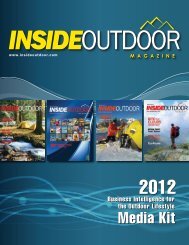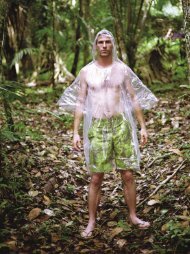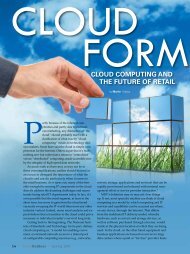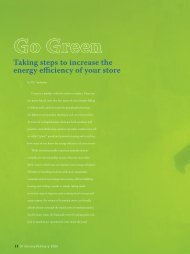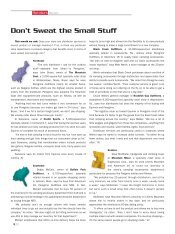Challenges of Green Design--Fall 2008
Challenges of Green Design--Fall 2008
Challenges of Green Design--Fall 2008
You also want an ePaper? Increase the reach of your titles
YUMPU automatically turns print PDFs into web optimized ePapers that Google loves.
Betting on<br />
a Better World<br />
Product designers face challenges working with<br />
eco-friendly materials<br />
by Martin Vilaboy<br />
The sourcing <strong>of</strong> eco-friendly materials<br />
and development <strong>of</strong> more sustainable<br />
products are proving to be daunting<br />
challenges for a goodly percentage <strong>of</strong><br />
businesses that have made the commitment<br />
to move toward green products<br />
and processes, suggest an Aberdeen Group survey<br />
<strong>of</strong> a cross section <strong>of</strong> consumer and commercial product<br />
suppliers from around the globe. And it’s much more<br />
than high cost and low availability <strong>of</strong> cleaner components<br />
and technology that are frustrating efforts.<br />
A full one-third to half <strong>of</strong> the firms taking green<br />
steps struggle to meet product launch dates and/<br />
or keep within development budgets. And right up<br />
there behind material costs and initial capex concerns,<br />
struggles within an uncertain regulatory and compliance<br />
environment is the number two challenge, say<br />
survey respondents.<br />
Indeed, the attempt to optimize products for environmental<br />
impact rather that just to meet government<br />
requirements, say Aberdeen analysts, “can present<br />
unfamiliar obstacles for engineers traditionally tasked<br />
with assessing product form, fit and function.”<br />
The reality <strong>of</strong> developing eco-friendly products “<strong>of</strong>ten<br />
requires product development teams to contemplate<br />
factors, materials and approaches that they traditionally<br />
would not have considered,” they continue.<br />
Not that it’s keeping executives from feeling<br />
quite green, at least not for now. More than half<br />
<strong>of</strong> companies have deployed some form <strong>of</strong> a design<br />
for a greener products strategy, according to<br />
a <strong>2008</strong> survey <strong>of</strong> engineer executives. All told, a<br />
whopping 96 percent <strong>of</strong> companies surveyed currently<br />
are pursuing at least one design for a green<br />
strategy. What’s more, the call to arms is coming<br />
from the top down, Aberdeen analysts argue, as<br />
36 | InsideOutdoor | <strong>Fall</strong> <strong>2008</strong>
push for change <strong>of</strong>ten generates from corporate and board<br />
level executives.<br />
To define “green” within this discussion, respondents were<br />
following three basic paths: products from or for recycled or<br />
reclaimed materials plus friendly disposal, reducing/eliminating<br />
natural resource consumption and emissions, and reducing<br />
packaging and logistics costs.<br />
In some ways, those higher-level executives feel as if they<br />
don’t have much choice but to move in these directions. The way<br />
things are viewed, you gotta give customers what they want.<br />
“Essentially, no executive can publically say no to a green<br />
initiative without public scrutiny <strong>of</strong> eco-friendly watch organizations,”<br />
Aberdeen analysts find.<br />
When asked about the drivers <strong>of</strong> greener<br />
product development, respondents listed<br />
corporate responsibility, conscientious customers<br />
and demand for better use <strong>of</strong> natural<br />
resources all among the top five, while<br />
a “corporate responsibility initiative” was<br />
named as a top driver by 74 percent <strong>of</strong> respondents<br />
in another recent survey.<br />
That’s not all good news, as it points<br />
to what’s arguably the biggest challenge<br />
so far with eco product initiatives: it’s difficult<br />
to measure the top and bottom line<br />
impact <strong>of</strong> growing social pressure to act<br />
responsibly. While there may be enormous<br />
pressure to go green, “it’s hard to<br />
quantify the advantage,” Aberdeen analysts<br />
point out.<br />
Traditional product development strategies<br />
can be measured directly, Aberdeen<br />
analyst argue, either in terms <strong>of</strong> dollars<br />
saved in a budget or a shortened cycle,<br />
but business benefits tied to improved<br />
branding and differentiation “are harder<br />
to measure and an order <strong>of</strong> magnitude<br />
removed, particularly with the product<br />
development organization.”<br />
And make no mistake, sales managers<br />
and financial <strong>of</strong>ficer types will need to<br />
hear about more than “s<strong>of</strong>t” benefits and<br />
proper public perception, much less the<br />
altruism <strong>of</strong> doing the right thing, in order<br />
to embrace the movement. For them,<br />
eco means an opportunity for growth, a<br />
means to differentiate what they see as a<br />
“commodity” product, findings suggest.<br />
In other words, it’s the desire for the proverbial<br />
“new and improved” product.<br />
The problems is, that won’t likely work<br />
for everyone. Certainly, there is heavy social<br />
pressure on corporations to lessen their<br />
environmental impact, and consumers like<br />
to think <strong>of</strong> themselves as doing their part<br />
to fight climate change. It still remains to be<br />
seen, however, whether or not consumers<br />
are willing to walk the walk with their wallets and pay the premium<br />
that’s still present most <strong>of</strong> the time.<br />
Surveys <strong>of</strong> retailers from both RSR Research and Retail Forward<br />
from earlier this year, for example, both cited little or no<br />
demand from consumers as a top barrier to introducing more<br />
green products into stores. More recently, a July <strong>2008</strong> survey <strong>of</strong><br />
more than 2,800 U.S. consumers age 16 years and older by Yankelovich<br />
suggests that Americans who are strongly concerned<br />
about the environment still represents a “niche opportunity,”<br />
says Walker Smith, Yankelovich president.<br />
“While (consumers) are highly aware <strong>of</strong> environmental issues<br />
due to the glut <strong>of</strong> media attention, the simple fact is that<br />
<strong>Fall</strong> <strong>2008</strong> | InsideOutdoor | 37
Building your Business<br />
for 2009 and Beyond<br />
Heat up your 2010 winter season with<br />
the hottest outdoor products. Come to<br />
Outdoor Retailer Winter Market to test<br />
drive the latest in product technology<br />
and innovations, preview material and<br />
fabric stories firsthand and participate<br />
in business building seminars and<br />
networking opportunities.<br />
JANUARY 22-25, 2009<br />
SALT PALACE CONVENTION CENTER<br />
SALT LAKE CITY, UTAH<br />
JANUARY 21, 2009<br />
SNOWBASIN SKI RESORT<br />
HUNTSVILLE, UTAH<br />
REGISTER TODAY AT<br />
WWW.OUTDOORRETAILER.COM
Top Five <strong>Challenges</strong> for Developing <strong>Green</strong> Products<br />
Challenge<br />
High expense associated with developing new technologies that are green or<br />
compliant<br />
43%<br />
Regulations differ widely according to regions and countries around the world 30%<br />
Difficulty measuring unconventional ROI on green products 25%<br />
Difficulty in understanding applicable regulations due to exemptions and<br />
shortages <strong>of</strong> knowledgeable employees<br />
24%<br />
<strong>Green</strong>er materials and technologies require new and large capital<br />
manufacturing investments<br />
24%<br />
Source: Aberdeen Group<br />
% <strong>of</strong> All Respondents<br />
DEALERS WANTED<br />
Top Five Pressures Driving <strong>Green</strong> Product Development<br />
Pressure<br />
Developing green products part <strong>of</strong> corporate social responsibility initiative 37%<br />
<strong>Green</strong> products <strong>of</strong>fer greater competitive product differentiation 35%<br />
Conscientious customers demand products that are more eco-friendly 28%<br />
Compliance to green related regulations required for market entry 26%<br />
Customers demand for products that use natural resources more efficiently 23%<br />
Source: Aberdeen Group<br />
% <strong>of</strong> All Respondents<br />
‘going green’ in their everyday life is simply<br />
not a big concern or a high priority,”<br />
says Smith.<br />
A mere 13 percent <strong>of</strong> those surveyed<br />
by Yankelovich, says Smith, are “strongly<br />
concerned” about the environment, while<br />
less than a quarter believe they can make<br />
a difference.<br />
And while Al Gore’s An Inconvenient<br />
Truth received widespread acclaim from<br />
the media and members <strong>of</strong> the scientific<br />
community, less than 20 percent <strong>of</strong> consumers<br />
saw the movie or read the book,<br />
say Yankelovich findings.<br />
Some may argue that the current economic<br />
crisis is distracting consumers from<br />
just about every other issue under the sun,<br />
including the environment. But no matter<br />
the reasons, such results already are raising<br />
questions about the potential bottomline<br />
benefits that can be derived from<br />
investing in socially responsible product<br />
development. Unless consumers begin to<br />
change their tune, one has to wonder how<br />
much patience American manufactures<br />
will show toward green investments outside<br />
<strong>of</strong> regulatory-driven necessities.<br />
Not that all hope is lost, by any means.<br />
In its sixth annual report on the carbon<br />
footprints <strong>of</strong> Global 500 companies, the<br />
Carbon Disclosure Project, a not-for-pr<strong>of</strong>it<br />
organization that acts as an intermediary<br />
between shareholders and corporations on<br />
climate change-related issues, argues that<br />
some companies confirmed billions <strong>of</strong> dollars<br />
in savings as a result <strong>of</strong> sustainability<br />
efforts in operations and packaging.<br />
Even within the seemingly pessimistic<br />
Yankelovich study, Smith makes the point<br />
that despite “most consumers’ lukewarm<br />
attitudes toward green,” companies that<br />
successfully convey the benefits <strong>of</strong> green<br />
attributes in a product can make those attributes<br />
a key feature in the buying decision<br />
<strong>of</strong> consumers who are just moderately<br />
concerned about climate change and the<br />
environment. That could include all but<br />
the 29 percent <strong>of</strong> consumers described by<br />
Yankelovich as “<strong>Green</strong>less,” or unmoved<br />
by environmental issues and alarms.<br />
Possibly most encouraging <strong>of</strong> all, Aberdeen<br />
researchers found a direct correlation<br />
between the length <strong>of</strong> time a company<br />
has been pursuing a green strategy and<br />
the level <strong>of</strong> success in generating a positive<br />
return from it. So companies that have<br />
had the opportunity to figure out what<br />
does and does not work well earlier than<br />
their manufacturer peers are dramatically<br />
more likely to hit launch dates, stick within<br />
budgets and minimize price increases.<br />
That seems to suggest that if manufacturers<br />
continue to push on, the premium<br />
price paid for greener products eventually<br />
goes away. And at that point, the need<br />
to change consumer behavior becomes<br />
much less <strong>of</strong> a factor.<br />
In the long term, eco-friendly product<br />
development could have a bright future.<br />
But that’s assuming manufacturers <strong>of</strong> all<br />
types can be persuaded to show patience,<br />
seeing how, in the nearer term, as we<br />
have said before, things likely get harder<br />
before they get easier.<br />
• Mulit-funtional gloves featuring •<br />
Thermolite ® Fibers<br />
• Keep you warm, even when wet •<br />
• Excellent P.O.P. display options •<br />
• MORE PROFIT PER PEG •<br />
Free<br />
sample pair for<br />
qualified dealers. Call us for<br />
more information<br />
800-426-8860<br />
atlasgloveconsumerproducts.com<br />
GO ANYWHERE • DO ANYTHING<br />
ATLAS® is a registered trademark <strong>of</strong><br />
SHOWA Glove Co. Thermolite® is a registered<br />
trademark for INVISTA certified performance<br />
fabrics containing proprietary INVISTA fibers.<br />
<strong>Fall</strong> <strong>2008</strong> | InsideOutdoor | 39




